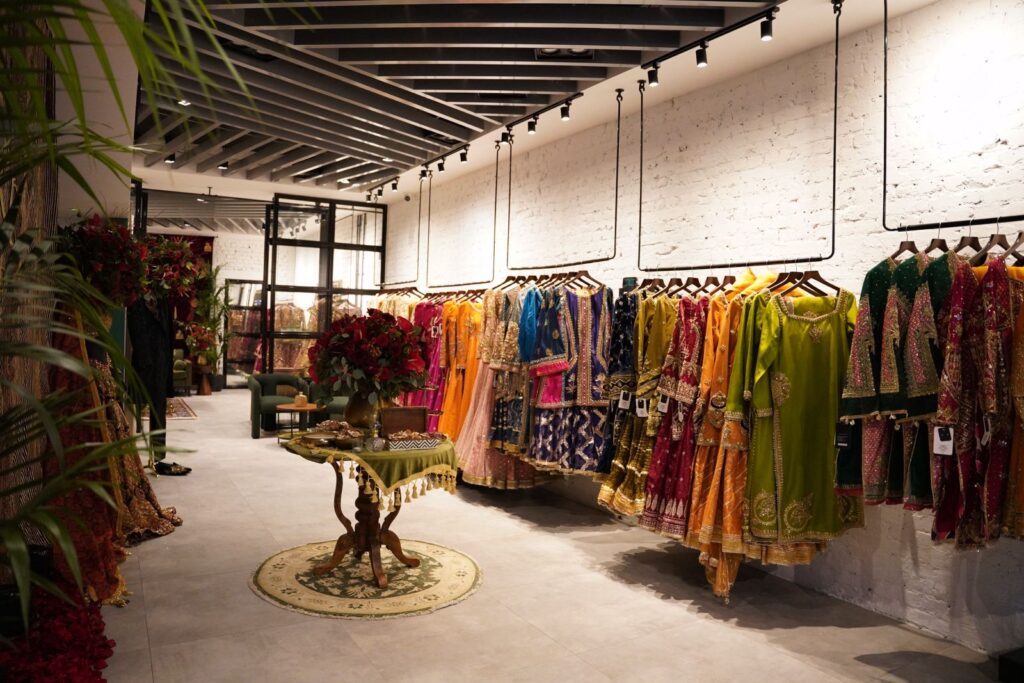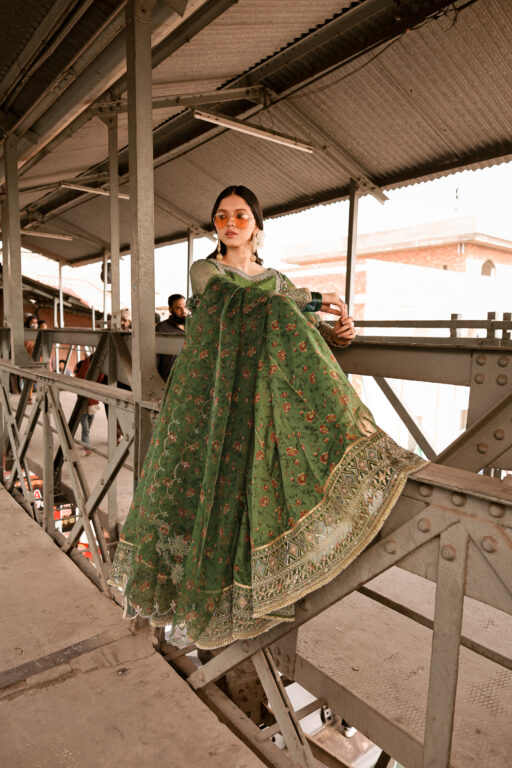
If tourists and travel bloggers haven’t said this enough already, I’ll say it again: Pakistan is a country rich in culture and craft that is diverse, distinct, and unique, all at the same time. Yet that richness seldom makes it past the confines of its home. There are obviously multiple factors involved — political instability, limited technological development and access, and a system that severely lacks organization. But there is no dearth of talent — including some who have defied all odds stacked against them to shine on a global stage. And among those is renowned fashion designer Mohsin Naveed Ranjha.
Known for his exquisite craftsmanship and fusion of traditional and contemporary aesthetics, Ranjha has quite a few firsts to his credit — he is the first designer to come out of Gujranwala, a quaint little town that’s perhaps known more for some of the worst rioting incidents in the country than its contributions to the fashion industry.
“I remember when we first opened our studio in Gujranwala and put up our board out in the front, people would come in and ask where they should sit to get their passport pictures taken,” Ranjha reminisced during a conversation with Brown Girl. “Even though the place was lined with mannequins and a good number of outfits, people would assume it was a digital photo studio because the concept of having a designer studio didn’t really exist there.”
“But things have changed now. Gujranwala has also become home to 30+ designers in the past decade or so.”

Ranjha is also the first mainstream Pakistani designer to expand into the heart of the “Big Four” fashion capitals of the world — London — or as leading Pakistani journalist Fifi Haroon once called it ‘London sharif’, with a standalone studio. Much like the plethora of privileged Pakistanis who flock to London, the hub of our colonial past, for a summer full of bustling streets and hi-teas, Ranjha, too, has a strange love for the city and always dreamt of setting up a base there.
“I love this city from the bottom of my heart; ek alag si mohabbat hai London se.”
The new concept store is a combination of Ranjha’s maximalist vision and his penchant for old-world glamour and romance. Fragrant bouquets of deep red roses, plush velvet tapestry, and rustic gold decor against lime-washed white, brick walls lend just the right amount of drama to Ranjha’s gamut of opulent, heavily-embellished outfits.
With a celebrity clientele boasting of names like Tan France, Karan Aujla, and Ranveer Singh and now a flagship studio in London, it’s safe to say that Ranjha is one of the few paving the way to international recognition for the Pakistani fashion industry even though industry veterans were quick to dismiss his fashion sensibilities when he first started out. Remember Vinay Khosla from Madhur Bhandarkar’s “Fashion?” Those characters exist for real! Ranjha, though, has always chosen to keep his head down and concentrate on his own goals.
Right before the launch of his swanky new studio, we spoke to Ranjha on standing his ground and looking past criticism, the significance of having commercial viability, and his foray into London’s vibrant fashion scene. Here are the excerpts:
The fashion industry can be very brutal to outsiders. Seniors are quick to criticize and dismiss. You, too, have received quite a bit of criticism on your fashion week outings. Was it challenging to make space for yourself in this cut-throat industry? Did it ever bog you down or make you question yourself?
When I first started out, it was very difficult to create a space for myself; the industry can be very uninviting and clannish. But the ‘never-say-never’ Punjabi guy that I am, I took it as a challenge to show everyone that I am here to stay and I can do it regardless. When I was not offered a seat at the table simply because I came from a small town, or when people dismissed me because I did not go to some fancy school in a big city, I only took it as motivation to do better. And honestly, had they been more welcoming towards me, I probably wouldn’t be where I am today.
I strongly believe that one shouldn’t worry about where they want to see themselves in the herd and instead just focus on the now; on honing in on your skills and improving, elevating your technique, and dreams will automatically turn into reality — be that opening a studio in London or the U.S.; it’ll just happen in due time.
I always had an innate love for our craft and wanted the world to see that we are not just another developing nation in Asia but that we, too, like our counterparts, are rich in diverse forms of craftsmanship. And I feel if you have that kind of desire, that genuine love for craft, the path becomes easier and things just start falling into place on their own.
I’ve been lucky that many fellow designers have praised me as well. Recently, I received so many calls and messages when I announced the launch of our new store in London, congratulating me and complimenting my work. Maybe they now realize and possibly even feel a bit embarrassed? But they always had my respect and always will.
Criticism can be positively constructive too. Do you feel you’ve also learned something from what was thrown your way?
Constructive criticism is like food for thought, it’s what drives one to do better; to improve and I am always open to that. I’ve learnt a lot from a lot of people, too. About a decade ago, there wasn’t really a culture to nurture up-and-coming designers or guide them. But things have changed over the years; senior designers are respecting and guiding new designers and not letting personal biases or jealousies come into play. Now I hang out with fellow designers, learn from them and even buy from them. There is competition, yes, but it’s healthy.

How would you describe the signature MNR aesthetic and envision a MNR bride?
I feel like I’ve been born into the wrong era. I admire and am inspired by old world glam and charm. My love for Urdu poetry reflects into the MNR aesthetic. Through our brand, I want to go back to my roots and highlight and promote our heritage and our craftsmanship — for instance, the deep connection that a South Asian bride has with the color red and the use of gota work and kiran that’s existed since the time of our grandmothers. You can spot a South Asian bride from far off…so the idea is to keep the timelessness and beauty of our culture, the inherent traditions and our heritage alive.
How important do you think the commercial aspect of a fashion business is compared to its distinctiveness of design? Do you feel a strong focus on commercial success and larger-than-life marketing campaigns take away from the true essence of a quality design?
If you don’t focus on the commercial and marketing aspect of your business, there is no way you’ll survive. You’re running a business at the end of the day. You’ve got to make money and be able to sell, not only to grow but also to continue pursuing your passion. I’ve seen many artists who have such an amazing portfolio of work but lack that sense of numbers or fail to add a commercial element and hence, struggle to make a place for themselves or even show the world what they’re all about.
The quality and design of one’s product however, is equally important. You may be able to sell a poor quality product with intense marketing, but you won’t last till the next season because your customer will see through it. They will associate your brand with being completely different from what’s being shown in the campaigns. For example, for our unstitched range, we give the same amount of fabric to our customers that is required to replicate the style and design shown in the campaign, which isn’t really the norm in the industry. When I first went with this approach, people questioned me. But I feel that when a customer opens up the box, they have an image of how they want it to look exactly like what the model’s wearing and if I am going to give them the standard 2.5 meters of fabric, I am just going to be disappointing them and I don’t want to do that.
If you can afford a grand marketing campaign, then do it for sure! But if the quality and the design of your product is compromised then that overnight fame and success will eventually fade away. Real success takes a lot of time, hard work and a strong team. It’s taken us a decade of dedication and commitment to our craft for us to finally reach London.

In an earlier interview, you mentioned how you dreamt of opening a studio in London. You’ve now realized that dream. Why was London, in particular, the goal, and how does it feel to see it come to life?
There were multiple reasons that motivated us to open a studio in London apart from it also being my favorite city. We have a lot of international clientele as well as celebrity clientele and it’s easier for them to reach out to the London studio and coordinate from here. Also gratefully, we have a huge fan-following in the UK; people really relate with and appreciate our aesthetic. We would constantly get bridal enquiries from a wide range of South Asian communities in the UK so it made complete commercial sense for us to have a base there.
We are also planning to introduce exclusive lines for the UK market that will fuse our brand’s traditional aesthetic with more modern cuts and silhouettes for a diverse range of customers and I am personally very excited and looking forward to that.
All that said, this is just beginning for us. We hope to continue growing and expanding across different countries.
In the past decade, Ranjha has extensively refined his brand identity — each Mohsin Naveed Ranjha outfit embodies the designer’s culture-driven vision instead of being a mish-mash of influences; to be able to develop a distinguishing imprint that remains intact collection after collection is no easy feat. Ranjha’s journey from humble beginnings in Gujranwala to becoming the boy wonder charting international territories is a testament to the fact that talent and sheer dedication to your craft trump all.
You can check out Mohsin Naveed Ranjha’s latest collection here.




